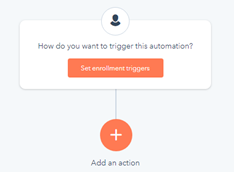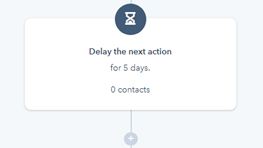

We’ve all heard it by now. HubSpot’s workflow tool can make almost anything work. From streamlining your sales processes to making sure your customers are feeling cared for and supported, the tool is dynamic beyond belief. What’s talked about less on the other hand, is the unexpected damage you can cause by simply toggling on that seemingly harmless little button in the top-right corner of the tool. Whether you want it to or not, your workflow structures and logic have the potential to affect your ENTIRE inbound marketing strategy. Well, maybe that’s a little dramatic, but still, you might want to keep reading to discover the dos and don’ts of workflows.
Enrollment Criteria
Let’s start at the top with enrollment criteria. Of course we think about who we do want included in a workflow when we begin building it out, but sometimes it’s harder to envision who we don’t want included in a workflow. For instance, while you might want people who visited your “Pricing” website page included in a workflow that sends them information about a new pricing promotion you are running, you might not think about excluding people who visited this page and are current customers paying the original price, even though you should.

Hopefully, you are creating specific, targeted content that will appeal to only certain contacts in your database. This means that only rarely do you want leads in your database getting the same automated emails as customers, or persona X getting the same automated emails as persona Y, and so on. Thankfully, HubSpot makes excluding and including the right people pretty easy. You can include/exclude based on lists, contact properties, page views, form submissions and so much more. BUT you have to use your head!
Put yourself in the shoes of someone enrolled in the workflow. Do you really want to be sending a “thank you for your recent purchase” email to someone who became a customer two years ago? Probably not. Therefore, while HubSpot makes it easy to enroll customers, you have to think beyond the basics and be sure to not enroll contacts who currently meet the enrollment criteria before you turn your workflow on, or only include contacts who became a customer in the past week.
Timing
Timing is everything and luckily for us, HubSpot understands the importance of this concept. Once again, try putting yourself in the shoes of someone enrolled in your marketing workflow. Do you really want to get a top-of-the-funnel, middle-of-the-funnel, and bottom-of-the-funnel email all in one day just because you expressed interest by opening the email? Probably not.
Think beyond “if/then branches” and people engaging with your content, think strategically. Just because someone expresses interest by opening your email or clicking on a link in your email, doesn’t mean they want an email encouraging them to request a demo two minutes later.

Even if people are engaging with your content or expressing interest, give people time to digest the content you are sending them, check out the resources linked in your emails, and explore your website. Be strategic about your delays, and try not to bombard your contacts with email after email in a short timeframe. Spread your emails out over the course of a few days or weeks depending on your average sales cycle and your overall marketing strategy.
Interferences
Before turning any workflow on, think big picture. Ask yourself how this workflow will coexist with other workflows you have currently running and whether or not it will interfere with those workflows. Will people be simultaneously enrolled in workflows with similar purposes? Will people be getting similar or double content if you turn your workflow on?
Let’s walk through an example. Say that you have a behavior-based workflow that is enrolling leads who visited a certain website page that nurtures them and encourages them to convert, but this was turned on a few months ago and you want to create another workflow that will give you an additional opportunity to reengage and re-nurture the leads that are in your database. You create a nurturing workflow with content that is slightly different than your original workflow, but accomplishes the same purpose. You enroll the leads in your database and turn it on. While this works for leads that are already in your database and went through the behavior-based workflow a few months ago, what about new, incoming leads? New leads that view the website page that enrolls them in the behavior-based workflow will also be enrolled in your new nurturing workflow. Therefore, you either want to be sure that the content and delays in both workflows make sense and complement each other, or you want to be sure to exclude the contacts that were enrolled in the first workflow from the second workflow.
Set it and DON’T Forget it!
The beauty of workflows is that they continue to work so we don’t have to, but this key feature has its downfalls. We have the tendency to finalize a workflow, turn it on, check it off our list, and forget to look back.
While some workflows withstand the test of time, others become outdated and need attention after they are turned on. Take our earlier workflow example that was sending contacts who visited the “Pricing” website page information about a pricing promotion. Let’s say that that promotion is only running through the month of March, we can’t forget to turn that workflow off after the promotion has run its course. In another example, your company might have recently rebranded, completely changing their logo and messaging. What does this mean for all of your workflow emails? You should probably update the content rather than continuing to promote old messaging and branding elements.

Make it a goal to check on your workflow performance and activity every week. Review email click rates, workflow goal performance, branching logic, enrollment criteria, and the content within each workflow email. If items aren’t performing well, see what you can do to improve them. If elements no longer apply or don’t make sense anymore, be sure to update them.
Conclusion
We all know that HubSpot’s workflow tool works magic and our marketing and sales systems wouldn’t be nearly as sophisticated as they are without it, but we must remember that there is a human element involved in the workflow creation process that the tool simply can’t account for on its own. The bottom line is, we must be smarter than the workflow tool, think big picture, and maintain a long-term mentality when creating workflows. There are so many items to consider when going through the creation process and, in an effort to improve our systems rather than diminish them, it’s truly worth it to think through all of these items before toggling that deadly little button on.

